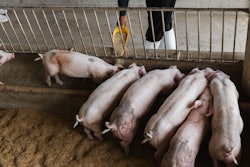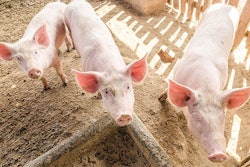
A senior government official in the Philippines says the disease should be treated as a national emergency.
Last week, the Chinese government further stepped up efforts to bring African swine fever (ASF) under control.
According to the South China Morning Post, among the latest measures are a ban on imports of live pigs and pork products from Malaysia since the first ASF outbreaks have been confirmed in that country. So far this year, there have also been six confirmed ASF outbreaks in domestic pigs in China.
After the loss of half of the Chinese pig population to ASF, the Beijing government recently described ASF as a “major risk factor” to the nation’s pork sector. Heavy mortalities unbalanced the pork market, and sent pork prices up sharply, which pushed up inflation for consumers in China. The authorities there have also begun to crack down on the use of fake and unauthorized vaccines of unknown efficacy.
In the past week, China’s agriculture ministry has confirmed one new outbreak of ASF in Sichuan province. According to the report to the World Organisation for Animal Health (OIE), a group of 10 pigs tested positive for the ASF virus at a highway checkpoint near Tianchi township in Guangan city prefecture in the east of the province. Two of the pigs died, and the presence of the highly virulent genotype II virus was confirmed. This was the eighth confirmed ASF outbreak in Sichuan since March 2020.
Recent reports of the emergence of new ASF virus strains has raised alarm in China and other counties.
After a previous ASF outbreak, China’s agriculture ministry reports that all movement restrictions have been lifted in the Xinjiang Uyghur autonomous region. This move comes after culling of all pigs in the affected area, and a 21-day period of continuous monitoring without any further detection of ASF virus.
Fears for future survival of Borneo wild pigs in Malaysia
Last week, Borneo Post reported official figures that at least 128 Bornean bearded pigs have died since ASF hit the Malaysian part of the island. Even before the disease arrived, this native population was in decline, according to the Deputy Chief Minister.
To prevent the extinction of the species, the minister convened a multi-stakeholder meeting to control and eradicate ASF from Sabah, which is a key pork-producing state in Malaysia.
It was decided to increase further public awareness campaigns about ASF, which have been carried out in Pitas, the first district to report cases of the disease. Efforts will be supported to control the spread of the infections, particularly on the safe disposal of wild pig carcasses.
Already, outbreaks have been confirmed in Pitas, Beluran, Kota Marudu, Lahad Datu and Kinabatangan, according to this source. Active surveillance has also led to the detection of ASF in Sandakan, Lahad Datu and most recently in Tawau. All eight of these districts are in the state of Sabah.
As well as 395 deaths among domestic pigs, the Department of Veterinary Services has arranged for the cull of a further 110 animals in backyard herds. So far, no cases of ASF have been detected on the state’s commercial pig farms.
The latest official report from Malaysia’s animal health authority to the OIE outlines three new ASF outbreaks among domestic pigs. Starting between February 11 and March 4, these involved a total of 102 pigs. These belonged to backyard herds of 12-50 animals in the districts of Pitas and Kota Belund in Sabah. A total of 15 wild boar found dead at various locations in the state also tested positive for the ASF virus.
Philippines: Ag secretary pushes for ‘national emergency’ status
Agriculture Secretary William Dar has requested that President Rodrigo Duterte declare the country’s ASF situation a “national emergency.”
Dar says ASF is decimating the local hog industry, reported Philippine News Agency (PNA). Affected so far have been 12 regions, 40 provinces, and 2,425 communities in the Philippines, he said, and more than 3 million pigs have been lost to the disease.
Resulting contraction in domestic pork production has led to an “unprecedented increases” in the prices of basic commodities. From 54,000 metric tons (mt), the minimum access volume for imported pork has been increased to 400,000 mt to help stabilize the pig meat market and prices.
The same source reports that the country’s ASF-free regions — including Central Visayas and Soccsksargen — have sent substantial numbers of live pigs and frozen carcasses to the National Capital Area, which includes Metro Manila. Aim of these movements are to stabilize markets and prices in the city.
Provinces sharing borders with infected regions continue to carry out health checks and quarantine on any transported pigs. In General Santos City, a task force has been set up to control online sales of pork. Its aim is to protect the local hog industry from the risk of incoming products from ASF-infected parts of the country. The city is located in the Soccsksargen region on Mindanao island.
Backyard hog raisers in three towns in the province of Leyte in Eastern Visayas are soon to receive first payments in compensation for their animals culled to control ASF. PNA reports that PHP7.9 million (US$163,000) is available to owners of the 15,800 pigs culled in Abuyog, La Paz and Javier since mid-January.
Philippines’ authorities have officially registered 622 ASF outbreaks to the OIE since August 2019. Of these, 155 are considered still to be ongoing. Affecting 33 out of the country’s 83 regions, almost 426,000 pigs have been directly impacted by the disease.
Latest situation in South Korea
No recent cases of ASF have been reported in South Korea. According to the agriculture ministry on March 12, 1,207 wild boar have tested positive for the ASF virus. These animals were found in 13 cities/provinces. In the north of the country near the border with North Korea, Gyeonggi and Gangwon provinces account for the majority of these cases.
April and May are the main months for the wild boar to produce new litters. The coming months are a high-risk period for the possible spread of ASF from wild species to domestic pigs on farms.
As a result of the government’s “multilateral quarantine measures,” there have been no confirmed outbreaks among South Korean domestic pigs since October 2020.
ASF situation in other Asian states: India, Indonesia
In February, OIE was informed about a further 433 outbreaks of ASF among backyard pigs in Indonesia. This brings the country’s total to 1,008 outbreaks since November 2019. More than 197,000 pigs have been directly impacted by the disease in 10 administrative areas of the country.
Local media in Indonesia have recently reported that ASF is suspected in Bangka Belitung Islands province, according to the United Nations’ Food and Agriculture Organization (FAO).
In the northeast Indian state of Meghalaya, the government is reported to be considering the release of funds to compensate owners of pigs lost to ASF.
According to a senior government official, 540 pigs were lost to the disease between June 2020 and February of this year, reports The Hills Times. More than INR1.8 million (US$249,000) have been spent by the state government in tackling the disease.
More ASF suspected in Oceania
In Timor-Leste (East Timor), the agriculture ministry has recently prohibited the slaughter of ASF-infected pigs. According to the FAO, the order applies to animals for household consumption and sale.
ASF has been spreading within Papua New Guinea, reports Post-Courier. From the first outbreaks in the central Highlands region one year ago, unconfirmed reports of elevated pig mortalities are now also coming from Tambul in the Western Highlands, and the province of Jiwaka. Fearing the infection may spread further still to Chimbu and Eastern Highlands, local officials are calling on pig owners not to move their animals, alive or dead.
Globally, ASF continues to be a major driver of pork markets, according to a report by international analysts. Causing uncertainty, the disease is particularly impacting China. The Vietnamese market has begun its recovery.
View our continuing coverage of the global African swine fever situation.


















